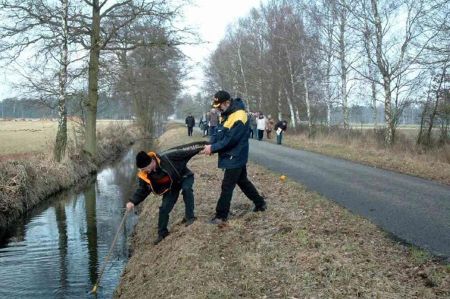Boßeln in Friesland / East Friesland
- Written by Portal Editor
Anyone traveling through Friesland / East Friesland as a tourist will occasionally come across warning traffic signs on somewhat remote roads, the typeface of which is unknown at least in large parts of Germany and is therefore sometimes misunderstood, especially when suddenly and unexpectedly a cheerful-looking group of active people appears athletes appear in the middle of the street, which one would hardly expect as a car driver.
If you were then also traveling too fast, you would at least shake your head uncomprehendingly, if not even be told if you couldn't understand the sign.
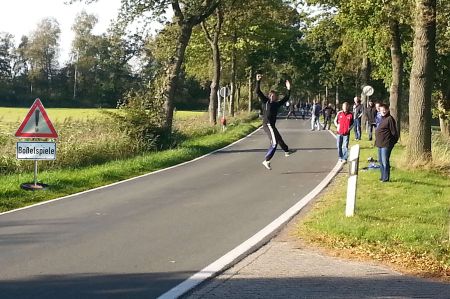 Mostly in winter, when the ditches are frozen over, the street bossel, which can almost be described as the national sport of the North Germans, is a popular leisure and club sport, which is often practiced on weekends but also as a social get-together with friends or acquaintances or as part of celebrations becomes. The sports activities are usually followed by a hearty meal of green cabbage in a convivial atmosphere.
Mostly in winter, when the ditches are frozen over, the street bossel, which can almost be described as the national sport of the North Germans, is a popular leisure and club sport, which is often practiced on weekends but also as a social get-together with friends or acquaintances or as part of celebrations becomes. The sports activities are usually followed by a hearty meal of green cabbage in a convivial atmosphere.
At the beginning of the Boßel event, two teams are usually formed, the aim of which is to bridge a predetermined distance with as few throws as possible by each individual in the team. The route to be completed extends over kilometers, includes curves, drops and slopes, so that there is a balance between strength and skill. Traditionally, a Pockholz Boßelkugel is used for one way and a mostly red hard rubber Boßelkugel for the way back.
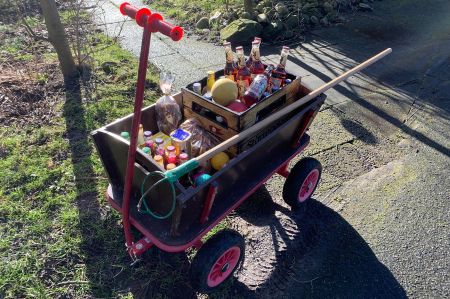 According to our research, Boßeln is said to have developed from another, typically North German sport, Klootshooting, around the end of the 19th century. As the streets were paved, the popularity of bossel sport grew steadily. After the Second World War, Boßeln finally developed into a leisure and popular sport, at least in northern Germany.
According to our research, Boßeln is said to have developed from another, typically North German sport, Klootshooting, around the end of the 19th century. As the streets were paved, the popularity of bossel sport grew steadily. After the Second World War, Boßeln finally developed into a leisure and popular sport, at least in northern Germany.
The "sports equipment" required for bowling are usually two different types of balls, with traditionally one bowl made of the hard wood of the guaiac tree, the so-called pockholter, being used, while the second ball was made of rubber. Both balls have a diameter of 12 centimeters (there are also balls with a diameter of 8.5 centimetres for young people). Today, plastic balls are also often used, but they are still called wood. Also of great importance are the so-called "Klootsoeker", small metallic baskets on a long pole, which are used to fish out Boßel balls that have rolled into the ditch.
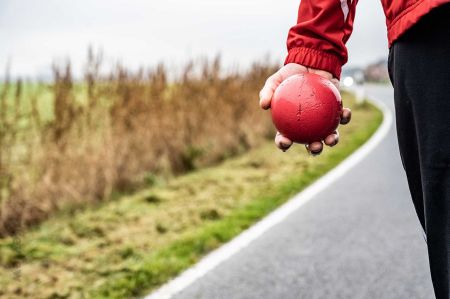 In the bossel throw, the arm is first moved backwards while running and then snapped forward again under the hand with a quick movement in order to release the bossel ball at high speed. It is important not to let the trajectory become too steep so that the ball can still roll as far as possible after landing on the street.
In the bossel throw, the arm is first moved backwards while running and then snapped forward again under the hand with a quick movement in order to release the bossel ball at high speed. It is important not to let the trajectory become too steep so that the ball can still roll as far as possible after landing on the street.
Through various throwing techniques, the Bossler can give the ball a spin that makes it possible to throw around a curve. In Low German, these techniques are called "överd Dum" (over the thumb) and "överd Finge" (over the finger). The normal release without spin is called "liek ut hand" (straight out of hand). In this way, on straight stretches with a suitable surface, top bossers can easily achieve distances of 200 meters with one throw with the rubber ball.
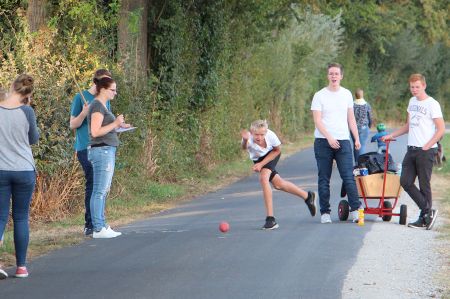 The North German street bossing is carried out as distance throwing on the street. Two teams (in official competitions, depending on the age group, in two or four groups with four throwers each) compete against each other. The teams take turns throwing, with the team behind having the first throw. Each thrower starts his throw at the landing point of his team's thrower. If the thrower from the team behind fails to make up the deficit, the opponent gets a point called a schoet or throw. The aim of the game is to score as many schoets as possible. The length of the route varies because the length of the throw varies depending on the condition of the road. It should be such that each thrower has to complete between ten and twelve throws. As a result, the total distance that players have to travel is several kilometres. In official game operations, a turn is required halfway through, where the type of bowling ball is also changed.
The North German street bossing is carried out as distance throwing on the street. Two teams (in official competitions, depending on the age group, in two or four groups with four throwers each) compete against each other. The teams take turns throwing, with the team behind having the first throw. Each thrower starts his throw at the landing point of his team's thrower. If the thrower from the team behind fails to make up the deficit, the opponent gets a point called a schoet or throw. The aim of the game is to score as many schoets as possible. The length of the route varies because the length of the throw varies depending on the condition of the road. It should be such that each thrower has to complete between ten and twelve throws. As a result, the total distance that players have to travel is several kilometres. In official game operations, a turn is required halfway through, where the type of bowling ball is also changed.
The long distance and frequent disruptions caused by traffic on the public roads mean that competitions last two to three hours and longer. Roads are only closed during major competitions such as the German Championships, where players and numerous spectators line the throwing distance. Today, bowling is widespread again as part of club championships, after the number of active athletes had been declining for a long time. Since there are now corresponding bossel competitions in other regions of northern Germany, national championships also take place. On a private level, there are many reasons to spend your free time with Boßeln, as there is often a celebration or a cabbage trip that is typical of the region.
Please read as well:
Aventicum - Amphitheatre and Roman Theatre awaiting us
The seaside resort of Saranda - just a stone's throw to Corfu
